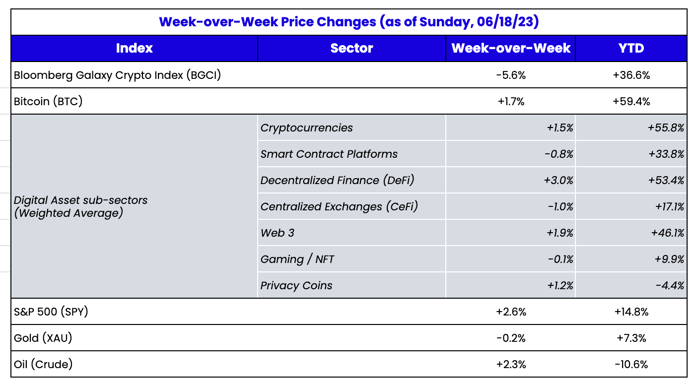


Similarly, Bitcoin’s strength continues to confound the masses after 2022’s weakness. Last week was no exception, as Bitcoin (BTC) jumped another +15% following Blackrock’s BTC ETF application, and now sits +84% YTD. BTC dominance (BTC.D), a mostly useless indicator given the constant additions of new non-Bitcoin tokens, has risen to 51%, its highest level since April 2021, showing just how much BTC has dominated overall digital asset returns.
“The crypto world is very good at creating groundbreaking technology, but new technologies without distribution often fail. Robo-advisors are a good analogy. Betterment and Wealthfront have amazing technology, but this technology was easily replicable by financial advisory powerhouses with larger distribution capabilities. So what happened? Every major financial advisory firm now offers similar technology services to their clients. Distribution and brand trumped technology.”
And That’s Our Two Satoshis!
Thanks for reading everyone! Questions or comments, just let us know.
Disclaimer: This commentary is provided as general information only and is in no way intended as investment advice, investment research, legal advice, tax advice, a research report, or a recommendation. Any decision to invest or take any other action with respect to any investments discussed in this commentary may involve risks not discussed, and therefore, such decisions should not be based solely on the information contained in this document. Please consult your own financial/legal/tax professional.
Statements in this communication may include forward-looking information and/or may be based on various assumptions. The forward-looking statements and other views or opinions expressed are those of the author, and are made as of the date of this publication. Actual future results or occurrences may differ significantly from those anticipated and there is no guarantee that any particular outcome will come to pass. The statements made herein are subject to change at any time. Arca disclaims any obligation to update or revise any statements or views expressed herein. Past performance is not a guarantee of future results and there can be no assurance that any future results will be realized. Some or all of the information provided herein may be or be based on statements of opinion. In addition, certain information provided herein may be based on third-party sources, which is believed to be accurate, but has not been independently verified. Arca and/or certain of its affiliates and/or clients may now, or in the future, hold a financial interest in investments that are the same as or substantially similar to the investments discussed in this commentary. No claims are made as to the profitability of such financial interests, now, in the past or in the future and Arca and/or its clients may sell such financial interests at any time. The information provided herein is not intended to be, nor should it be construed as an offer to sell or a solicitation of any offer to buy any securities, or a solicitation to provide investment advisory services.
These Stories on Market Recap